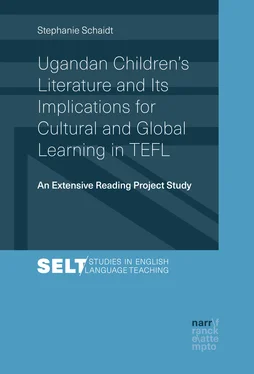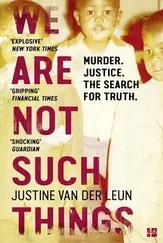The students made their reading diary entries in German. The decision to choose this language was consciously taken because all the students participating in the study were fluent in this language. The limited English proficiency of some of the learners might have led to difficulties in expressing their thoughts and emotions in the target language which in turn could have influenced their responses (see Fäcke, 2006, p. 73). Thus, all diary entries, with exception of the creative tasks in the post-reading section, were written in German. The responses to the creative writing tasks were done in English because these tasks required working with the English texts, i.e. writing another ending for the story, changing the narrative perspective of the story or writing a letter to one of the characters.
The students were asked to write in their reading diaries before, while and after reading the literary text (see Appendices E and F). Before reading, the students could, for example, describe their expectations concerning the text or elaborate on their prior knowledge about the topic as it was reflected in the title or the book cover. Thus, the students were encouraged to activate schemata prior to reading which could aid their understanding process during reading. Entries in this section of the reading diary intended to make students’ expectations visible for the researcher and give further insights into the students’ prior knowledge. During the reading process, the prompts in the reading diary aimed at obscurities the learners came across while reading, the emotions which the literary text evoked in the readers and their favourite quotes of the narratives. In this part of the reading diary, the students were encouraged to think about what is happening in the story and to simultaneously note down their thoughts and feelings. The intention here was to provide insights into the reader’s thoughts and feelings which emerged during the reading process. In the ‘after-reading’ section of the diary, the students were then encouraged to retrospectively reflect on their reading, on expectations that might have been confirmed or changed, and on aspects they particularly liked about the text and those which they disliked. They could also compare the content of the text with their own lives. Moreover, they were encouraged to move beyond the text and their own reactions and reflect upon their reading process. They could, for example, note down whether the text was difficult for them and why this might have been the case. Thus, the focus of this section of the reading journal was placed on the reader’s retrospective reflection of the reading process. Other post-reading activities consisted of text specific tasks. For each text, I provided two analytical and two creative prompts from which the students could choose. These tasks differed from text to text and required detailed understanding of the text. The analytical tasks focused on the meaning of certain paragraphs, the actions of characters and the reader’s own opinion concerning these parts of the text. The creative writing tasks (e.g. letters by characters, dialogues between characters, etc.) required imagining, empathising, and comparing.
There are several reasons why reading diaries are used in this study. First of all, they can document the whole reading experience of the students, whereas other introspective methods of data collection such as thinking-aloud commentaries are usually only able to focus on short texts or parts of longer texts. Thus, reading diaries give insights into the students’ reading process of longer literary texts (Fäcke, 2006, p. 73). Moreover, reading diaries which are written over a longer period of time also make students’ progress during the reading process visible (Mosner, 2000, p. 93). In case of the extensive reading project which was conducted over a period of three months, the documentation of students’ responses gave insights into the developments students went through while reading different texts of Ugandan children’s fiction. Another argument in support of reading diaries as research instruments is the low degree of structuring and monitoring by the researcher. This may encourage students’ autonomy and confirm their anonymity, which in turn might lead to more open and honest answers than, for example, in thinking-aloud commentaries. Diary studies in general also leave room for individuality and thus they “can give teachers and researchers insights on the incredible diversity of students to be found even within a homogenous language classroom” (Bailey, 1983, p. 98).
Making use of reading diaries as research instruments, however, also confronts the researcher with a number of problematic aspects. It is, for example, frequently criticised that diary entries do not necessarily reflect “what was really going on at the time the recordings were made” (Nunan, 1994, p. 123). Since the students are aware that their diaries are read by the researcher, they may address their responses to her/him. They may, for example, exaggerate or withhold data and present their responses in such a manner that they think is viewed favourable by the researcher. When evaluating the responses of the students, therefore, influences of social desirability have to be considered. However, it has to be noted that as in the case of questionnaires the lack of face-to-face contact between the researcher and the students might facilitate responses to sensitive matters better than the direct contact in, for example, an interview. Another aspect which can be both advantageous and problematic is the low degree of structuring and control of reading diaries. Writing reading diary entries requires much time and commitment, which some students wish to avoid. This also became apparent in my study as a number of students wrote very short diary entries and two students did not write any entries in their reading diaries at all.
To validate the data which were collected via the questionnaires and reading diaries, and to gain a deeper insight into the students’ reading experiences, semi-structured interviews were conducted. Since the primary aim of this research project is not to measure responses and make generalisations from data but rather to capture the uniqueness of the individual case, a rather open-ended interview format was required. I therefore made use of guiding questions but still followed topical trajectories which strayed from the guide whenever necessary:
Semi-structured interviews are based on a set of prepared, mostly open-ended questions, which guide the interview and the interviewer. This interview guide should be applied flexibly and leave room for the interviewee’s perspective and topics in addition to the questions. (Flick, 2014, pp. 197–198)
According to Nunan (1994, p. 150), benefits of the semi-structured interview are that on the one hand “it gives the interviewee a degree of power and control over the course of the interview” and on the other hand “the interviewer a great deal of flexibility.” Therefore, it may permit a profound and deep insight into peoples’ lives.
In order to enable the students to talk freely about their experiences, the interviews were conducted in German. The setting was a classroom and the teacher was not present during the interview. The interviews were tape-recorded and I took additional notes.
Questions in the interviews were open and thus allowed expansion and elaboration in the students’ responses. In order to facilitate comparability of the responses across the interviewees the questions were arranged in topic areas and a number of standardised questions were addressed in all interviews.
I made use of an interview guide in which the topics and issues to be covered in the interviews were listed. This outline “increases the comprehensiveness of the data and makes data collection somewhat systematic for each respondent” (Patton, 1980, p. 206). At the same time, it facilitates that interviews “remain fairly conversational and situational” (ibid.).
Читать дальше












